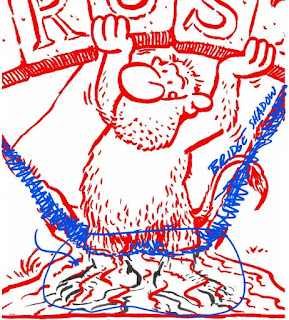I received positive feedback from the SCBWI Michigan conference team on the three concept sketches. They liked the cave scene and asked if the dragon could be included. They even gave the OK for a 980 x 500 px banner to give me more room for the dragon. Yay!
The first thing I did was to mock up the composition in
ArtRage. I didn’t realize how much
bigger 1080 pixels would be than 200 or 500 pixels!
My initial attempt was to just make the stalagmites really tall and the elevator would stay in the same position for all three
formats with the dragon showing up in the two larger ones, which you can see in
the dull red and dull green shapes.
I drew some items with digital ink and others with digital pencil. I thought the pen drawn elements would be
stronger in the foreground and the pencil ones would fade into the
background. It didn’t seem to work as
well as I thought.
I also played with the layer blend modes to create the
headlamp spotlight effect. I just made a
yellow-orange triangle shape on a separate layer and found the screen blend
mode worked pretty well when reducing the opacity a little bit, too.
I felt the stalagmites looked too tall and the elevator
looked cramped at the top in the square format.
Since I had drawn many of the elements on different layers, it was easy
to rearrange them into this composition, which was closer to my PowerPoint
rough comp.
Throughout this illustration process, I used a combination of digital and traditional tools. Periodically, I reviewed print outs to look more critically at the piece, which is what I did here. Scale up the miners. Make sure there is value contrast with the spotlight and background. New ideas came. The spear shape at the end of the dragon’s tail would become a pen nib. Hidden jewels might be in CMY (Cyan, Magenta, Yellow) colors.
Based on the printout I scaled up my drawing on 11x17
tabloid copy paper. I started with the
primary elements: the gopher and mole in the elevator, the dragon, the timid
goblin, and the pen, pencil, and paintbrush in the stalactites and
stalagmites. Then my mind wandered
around the rest of the cavern, imagining what else might be hidden there: a
stack of books, glass inkwells, an iPad, a dwarf on a bridge.
Here are some other sketches.
Another version was drawn on tabloid paper, shifting things
a bit and polishing up some of the ideas.
I had also done some research with Google, looking up mine elevator,
which drove the change from a chain and gear mechanism to a simple hook and
cable.
I tried out a few different pencils and techniques to draw the
stone textures and the characters. I
used the flat of the pencil tip and danced it around a bit for the most part. Then scanned them into Photoshop with my
Plustek Optic Pro A320L scanner and was happy with the combination of
traditional pencil and digital color.
While driving to work after the holiday break, I thought I
should try to include something about Michigan to represent our SCBWI chapter. Brianne
Farley did a great job of this with the SCBWI Michigan website banner,
which included a state bird – a robin, state flower – an apple blossom, sand
dunes, and a lake. My idea? Incorporate the shape of Michigan’s upper and
lower peninsula into the depths of the cave.
As soon as I got to my desk, I sketched it up. I imagined the thin strip of water between
the upper and lower peninsula as the narrow bridge in the Mines of Moria, where
Gandalf defended it against the fiery Balrog. The state outlines would be in the negative
space of the cavern’s darkness.
Once back at the computer, I played around with the scale
and placement of a Michigan map on my scanned in pencil drawing and created the
layered look I was after.
Once I confirmed that the conference team was onboard with
the concept, it was time to make the “finished” pencil drawings.


































